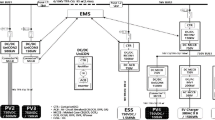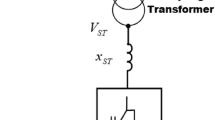Abstract
In this paper, a new time-domain-based method is proposed for fault location in HVDC transmission lines. In the proposed method, an equation is derived for locating the fault for different transmission-line models (lumped-line model, \(\uppi \)-line model, and distributed-line model). Then, a method is suggested to precisely determine the transmission-line resistance using DC component of voltage and current at the both terminals (pre-fault). The performance of the proposed method is evaluated based on a test system by the PSCAD/EMTDC and MATLAB software. The performance and precision of the proposed methods are evaluated for short-circuit fault in different conditions, such as different fault resistances, difference fault distances, different minimum injected current of the inverter during the fault, and different pre-fault conditions. The simulation results confirm that the proposed method is much more accurate in locating faults compared to other counterparts.






Similar content being viewed by others
Notes
Kirchhoff voltage law.
Abbreviations
- x :
-
Fault distance (distance between the fault location and the rectifier terminal)
- R :
-
Defined as the resistance per unit of the line length
- L :
-
Defined as the inductance per unit of the line length
- C :
-
Capacitance of the line in per unit
- \(U_\mathrm{f}^\mathrm{rec}({t})\) :
-
Voltage of the fault location based on the rectifier data
- \(i_\mathrm{rec}({t})\) :
-
The recorded current at the rectifier terminal
- \(U_\mathrm{rec}({t})\) :
-
The recorded voltages at the rectifier terminal
- l :
-
Total transmission-line length
- \(u_\mathrm{inv}({t})\) :
-
The recorded voltage at the inverter terminal
- \(u_\mathrm{f}^\mathrm{inv}(\hbox {t})\) :
-
Voltage of the fault point based on the inverter data
- \(i_\mathrm{inv}({t})\) :
-
The recorded current at the inverter terminal
- \(u_\mathrm{rec} \left( \mathrm{DC} \right) \) :
-
DC component of the recorded voltage at the rectifier terminal
- \(u_\mathrm{inv} \left( \mathrm{DC} \right) \) :
-
DC component of the recorded voltage at the inverter terminal
- \(i_\mathrm{rec} \left( \mathrm{DC} \right) \) :
-
DC component of the recorded current at the rectifier terminal
- \(i_\mathrm{inv} \left( \mathrm{DC} \right) \) :
-
DC component of current at the inverter terminal
- \(u_\mathrm{F}\) :
-
Fault point voltage
- \(R_\mathrm{F}\) :
-
Fault resistance
- \(I_\mathrm{F}\) :
-
Fault current at the fault point
- \(x_\mathrm{actual}\) :
-
The actual and real fault distance
- \(x_\mathrm{calculated}\) :
-
The calculated fault distance
- \(l_\mathrm{t}\) :
-
Total length of line
- FFT:
-
Fast Fourier transform
- \(u_\mathrm{rec} \left( \mathrm{DC} \right) \) :
-
DC component of the voltage at the rectifier terminal
References
Mokryani G, Haghifam MR, Esmaeilpoor J (2009) Identification of Ferro resonance based on wavelet transform and artificial neural network. Eur Trans Electr Power 19(3):474–486
Mokryani G, Haghifam MR (2010) Detection of inrush current using S-transform and probabilistic neural network. In: Transmission and distribution conference and exposition. IEEE PES, New York, pp 1–6
Mokryani G, Haghifam MR (2010) Detection of inrush current based on wavelet transform and LVQ neural network. In: Transmission and distribution conference and exposition. IEEE PES, New York, pp 1–5
Clerk Maxwell J (1892) A treatise on electricity and magnetism, vol 2, 3rd edn. Clarendon, Oxford, pp 68–73
Rahmati A, Abrishamfar A, Abraham JO (2008) A VSC-HVDC system without sensor for asynchronous active network connection. Iran J Electr Eng Comput Eng 2
Achab E, Castro LM (2016) A generalized frame of reference for the incorporation of, multi-terminal VSC-HVDC systems in power flow solutions. Electr Power Syst Res 136:415–424
Song G, Chu X, Cai X, Gao S, Ran M (2014) A fault-location method for VSC-HVDC transmission lines based on natural frequency of current. Int J Electr Power Energy Syst 63:347–352
Yi-ning Z, Yong-Hao L, Min X, Ze-Xiang C (2011) A novel algorithm for HVDC line fault location based on variant travelling wave speed. In: 4th electric utility deregulation and restructuring and power technologies int. conf, pp 1459–1463
Nanayakkara OMKK, Rajapakse AD, Wachal R (2012) Location of DC line faults in conventional HVDC systems with segments of cables and overhead lines using terminal measurements. IEEE Trans Power Deliv 27(1):279–288
He ZY et al (2014) Natural frequency-based line fault location in HVDC lines. IEEE Trans Power Deliv 29(2):851–859
Lian B, Salama MMA, Chikhani AY (1998) A time domain differential equation approach using distributed parameter line model for transmission line faulty location algorithm. Electr Power Syst Res 46(1):1–10
Farshad M, Sadeh Javad (2014) A novel fault-location method for HVDC transmission lines based on similarity measure of voltage signals. IEEE Trans Power Deliv 28(4):2483–2490
Li Yongli, Zhang Shuo (2012) A fault location method based on genetic algorithm for high-voltagedirect current transmission line. Euro Trans Electr Power 22:866–878
Yuansheng Liang, Gang Wang, Haifeng Li (2015) Time-domain fault-location method on HVDC transmission lines under unsynchronized two-end measurement and uncertain line parameters. IEEE Trans Power Deliv 30(3):1031–1038
Grainger J, William S (1994) Power system analysis. McGraw-Hill, New York, pp 202–215
Cigre WG (1991) First benchmark model for HVDC control studies. Electra 55–75
Author information
Authors and Affiliations
Corresponding author
Rights and permissions
About this article
Cite this article
Daisy, M., Dashti, R. & Shaker, H.R. A new fault-location method for HVDC transmission-line based on DC components of voltage and current under line parameter uncertainty. Electr Eng 99, 573–582 (2017). https://doi.org/10.1007/s00202-016-0384-3
Received:
Accepted:
Published:
Issue Date:
DOI: https://doi.org/10.1007/s00202-016-0384-3




